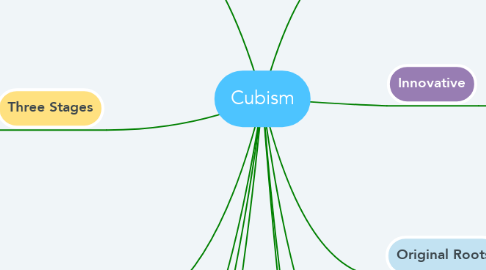Cubism
by Olivia Telemaque


1. Reinventing Art
1.1. Multiple Angles
1.2. Use of Space
1.3. Broken Medias
1.4. No Shading, No Illusions
1.5. Produce a Mood of Art
1.6. Simplified
1.7. Depicts a sense of Truth
2. Three Stages
2.1. Early Cubism
2.1.1. Whole Piece
2.1.1.1. Multiple Angles
2.1.2. 1906-1914
2.2. Analytical Cubism
2.2.1. Broken
2.2.1.1. Reordered
2.2.1.1.1. Muted Color
2.2.2. 1909-1912
2.3. Synthetic Cubism
2.3.1. Cut and Paste
2.3.1.1. Texture
2.3.1.1.1. Color
2.3.2. 1912-1914
3. Famous Pieces
3.1. The Vase, Bowl, Lemon
3.2. Clarinet and Bottle of Rum on a mantelpiece
3.3. Violin and Pitcher
3.4. Still Life
4. 1906-1914
4.1. ARTISTS MOVEMENT
4.1.1. PAINTING
4.1.2. Variety of Materials
4.1.3. OBJECTS (Still Life)
5. Defiant to Artistic Norms
6. Style of Art
7. Influencers
7.1. Pablo Picasso
7.2. Georges Braque
7.3. Juan Gris
8. Innovative
8.1. Depictions of Reality
8.2. Hidden Truths
8.3. Underlying Meanings
8.4. Not always fully accepted
9. Original Roots
9.1. African Pieces
9.1.1. Paul Cezanne
9.1.2. Georges Seurat
9.1.3. Paintings
9.1.3.1. Sculpture
10. 2-D
11. Different Perspective
12. MODERN IMPLICATIONS
12.1. Fashion
12.1.1. Film
12.1.1.1. Photography
12.1.1.1.1. Collages

